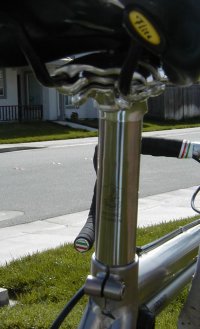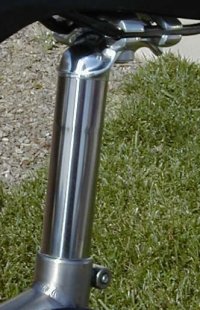What can you say about
a seatpost? It's one of those "forgotten"
pieces of equipment that's only noticed when it breaks or
is adjusted wrong.
Still, there is a wide
range of seatpost options out there, and Campagnolo has
added its share over the years. For 1999, Campy offers
only one seatpost--the Titanium Record--which Campagnolo
sent us for testing several months ago. (Interestingly,
last year, Campagnolo failed to iron out production
glitches and never got around to shipping the Record
seatpost. This year, they are offering only the
Record version. If you're putting together a brand-new,
all-Campagnolo bike, you'll be using this seatpost!)
A few observations:
- Our first impression out of the
box was that this is a gorgeous piece of metal.
The Ti shaft is highly polished, the alloy clamp
has been given the full Campagnolo polishing, and
the design is very high-tech. It's not beautiful
in the manner of a Super Record post, but it's
thoroughly modern and at home on the most exotic
road machine.
- The shaft is extra-long--you could
easily use this post in a mountain bike (as long
as it needs a 27.2 post).
- The clamping mechanism does away
with the friction-fit, wedge-style adjustment of
recent years. In its place, Campy has provided a
knurled fitting--tiny ridges on the bottom of the
seat rail clamp engage with similar ridges on the
top of the post. Set this one and forget it--it's
not going to move anywhere. On the down side, at
least one rider has expressed to us his
frustration with the post--his potimum seat angle
lies somewhere between two of the knurls, and he
can't get the seat adjusted to his liking. The
clamping bolt is a size larger than on Campy's
former designs.
- The clamping mechanism also allows
the seat to be moved waaaaay
back--farther than any Campy post in recent
memory. For those of us who emulate Greg Lemond's
"laid-back" style, that's great news.
- The finish is great, but the
"laser etched" Campy logo on the back
side is hard to read. You have to get really
close to see it; anyone not in the know will have
a hard time figuring out who made it.
- Does it ride better? One reader
suggested that the Ti shaft would have a slight
amount of "give," making for a more
comfy ride. We couldn't tell a difference on our
Ti Merlin, but on a very stiff frame you might
detect a slight improvement in ride. If you do, let us know.
- This guy is expensive. A quick
review of retail prices will show that, at about
$120 each, this is about the most costly option
out there for holding up your seat. When you
consider that a very workable (non-Campy)
aluminum post can be had for less than $20, and
that complete bikes are sitting in your LBS for
$250, the cost really hits home.
Worth it? Well,
you're getting a great design in last-forever
Titanium, as well as a substantial weight
reduction (about two ounces lighter than a '97
Chorus alloy post). Perhaps more to the point--if
you're worried about cost, you won't even be
looking at parts at this lofty level. Crack the
wallet open, take a deep breath, and do it.
Barring an errant bus running over your bike,
this is certainly the last seatpost you'll ever
need to buy, so think of it as a long-term
investment.
 |
|
 |
| Photo above:
The finish on the seatpost is great--highly
polished Ti and aluminum. |
|
Photo above:
View from the rear. Barely visible (even in
person) is the laser-etched Campy crest. |
| |
|
|
 |
|
 |
| Photo left:
Closer view of the seatpost from the front. |
|
Photo right:
Close-up of the clamp. Also visible is the slight
bulge in the Ti shaft, where the forged top has
been inserted. |
|
